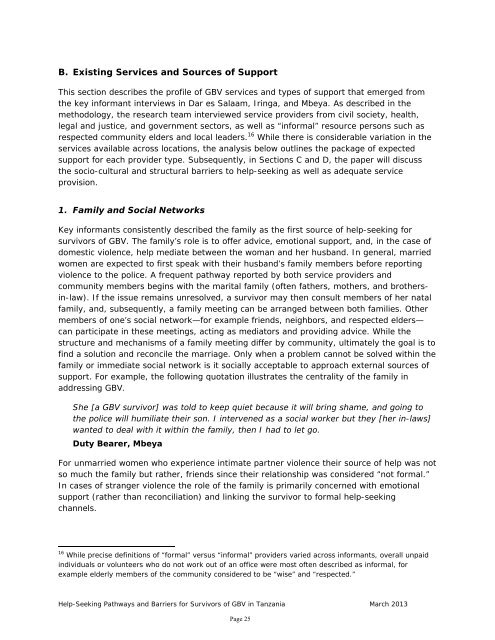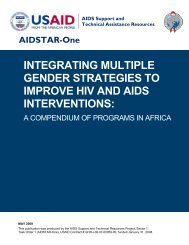Download PDF - ICRW
Download PDF - ICRW
Download PDF - ICRW
You also want an ePaper? Increase the reach of your titles
YUMPU automatically turns print PDFs into web optimized ePapers that Google loves.
B. Existing Services and Sources of Support<br />
This section describes the profile of GBV services and types of support that emerged from<br />
the key informant interviews in Dar es Salaam, Iringa, and Mbeya. As described in the<br />
methodology, the research team interviewed service providers from civil society, health,<br />
legal and justice, and government sectors, as well as “informal” resource persons such as<br />
respected community elders and local leaders. 16 While there is considerable variation in the<br />
services available across locations, the analysis below outlines the package of expected<br />
support for each provider type. Subsequently, in Sections C and D, the paper will discuss<br />
the socio-cultural and structural barriers to help-seeking as well as adequate service<br />
provision.<br />
1. Family and Social Networks<br />
Key informants consistently described the family as the first source of help-seeking for<br />
survivors of GBV. The family’s role is to offer advice, emotional support, and, in the case of<br />
domestic violence, help mediate between the woman and her husband. In general, married<br />
women are expected to first speak with their husband’s family members before reporting<br />
violence to the police. A frequent pathway reported by both service providers and<br />
community members begins with the marital family (often fathers, mothers, and brothersin-law).<br />
If the issue remains unresolved, a survivor may then consult members of her natal<br />
family, and, subsequently, a family meeting can be arranged between both families. Other<br />
members of one’s social network—for example friends, neighbors, and respected elders—<br />
can participate in these meetings, acting as mediators and providing advice. While the<br />
structure and mechanisms of a family meeting differ by community, ultimately the goal is to<br />
find a solution and reconcile the marriage. Only when a problem cannot be solved within the<br />
family or immediate social network is it socially acceptable to approach external sources of<br />
support. For example, the following quotation illustrates the centrality of the family in<br />
addressing GBV.<br />
She [a GBV survivor] was told to keep quiet because it will bring shame, and going to<br />
the police will humiliate their son. I intervened as a social worker but they [her in-laws]<br />
wanted to deal with it within the family, then I had to let go.<br />
Duty Bearer, Mbeya<br />
For unmarried women who experience intimate partner violence their source of help was not<br />
so much the family but rather, friends since their relationship was considered “not formal.”<br />
In cases of stranger violence the role of the family is primarily concerned with emotional<br />
support (rather than reconciliation) and linking the survivor to formal help-seeking<br />
channels.<br />
16 While precise definitions of “formal” versus “informal” providers varied across informants, overall unpaid<br />
individuals or volunteers who do not work out of an office were most often described as informal, for<br />
example elderly members of the community considered to be “wise” and “respected.”<br />
Help-Seeking Pathways and Barriers for Survivors of GBV in Tanzania March 2013<br />
Page 25

















